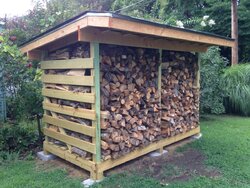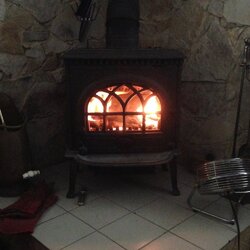After all the years burning wood for heat this season has been full of new learning. Prior to this season I built a wood shed. What a difference burning dry wood compared to burning wood I thought was dry. My burn times were much longer and much hotter too. If I would have know the benefits of having dryer wood I would have taken out a loan to build this shed years ago. LOL Next year my wood will not only be dryer but seasoned properly also. I have wood split from last summer under a tarp and ready to move into the shed after this season.

The only issue I had this winter was when the temps got into the teens and lower. It seemed like my little Jotul 3CB was not up to the task. When the temps were between the mid 20's to mid 30's I was able to maintain 74° in my home without a problem. My 900 sg. ft. house is all masonry construction. So when it was cold for a while it was harder to keep warm. But the advantage is when it has been warm for a while it takes a good day or two to cool down. I thought about upgrading to a Jotul Castline 400 but I am worried that during the warmer days a larger stove will be too hot. When the temps are in the 40's I do have to be careful not to load up the stove with a full load, so instead I put a piece or two in every couple of hours so I don't loose my fire.

This is the second year I have had this Jotul 3CB, years before I had a inexpensive boxwood stove. Any thoughts on the Castline 400?

The only issue I had this winter was when the temps got into the teens and lower. It seemed like my little Jotul 3CB was not up to the task. When the temps were between the mid 20's to mid 30's I was able to maintain 74° in my home without a problem. My 900 sg. ft. house is all masonry construction. So when it was cold for a while it was harder to keep warm. But the advantage is when it has been warm for a while it takes a good day or two to cool down. I thought about upgrading to a Jotul Castline 400 but I am worried that during the warmer days a larger stove will be too hot. When the temps are in the 40's I do have to be careful not to load up the stove with a full load, so instead I put a piece or two in every couple of hours so I don't loose my fire.

This is the second year I have had this Jotul 3CB, years before I had a inexpensive boxwood stove. Any thoughts on the Castline 400?


